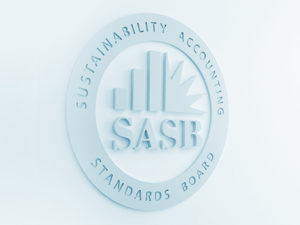Today, The Task Force on Climate-Related Financial Disclosure (TCFD) issued its long-awaited final Recommendations report, designed to help companies understand what type of financial disclosure best enables the markets to measure and respond to climate change risk. SASB shares this goal and applauds the TCFD for achieving this milestone.
SASB and the TCFD share the belief that climate change is one of the biggest economic risks the world faces today. As such, SASB and the TCFD believe that climate risk is often material, and as such, disclosure belongs in mainstream financial filings. The TCFD report has made a great contribution to the dialogue by dispassionately presenting climate impacts in terms of their financial risks to companies and their investors, which makes it relevant and actionable by the markets.
SASB research has found that climate change is likely to have material financial impacts on companies in 72 out of 79 industries, representing 93 percent of the U.S. equity market, or $27.5 trillion. However, it manifests differently in each industry. To evaluate climate risk, investors need an understanding of climate’s industry-specific impacts, and industry-specific metrics to evaluate this risk. SASB standards provides insight into unique climate impacts—including physical impacts, climate regulation, and transition to a low-carbon, resilient economy—at the industry level. Although 75 percent of SASB’s climate-related disclosure topics are being disclosed in SEC filings, more than 40 percent use boilerplate, while only 17 percent use metrics. Our goal—one shared with the TCFD—is to improve the quality of this disclosure.
SASB is proud to be referenced by the TCFD as an appropriate framework by which to fulfil the TCFD recommendations. SASB standards are a way to implement the TCFD guidelines consistent with the definition of materiality in U.S. securities law.
We are committed to supporting the work of the TCFD and promoting its recommendations. Our goal is to further harmonize SASB’s standards with the TCFD’s recommendations. To work towards this goal, SASB is taking the following steps:
- Undertaking a review of its 79 industry standards—evaluating each standard, topic, metric, and associated technical protocol in the context of the four thematic areas for which the task force provided recommendations (governance, strategy, risk management, and metrics and targets)—with the objective of bringing them into closer alignment with the TCFD recommendations.
- Identifying a combination of cross-cutting and industry-specific changes to the standards, which will be vetted against the SASB Conceptual Framework, supported with additional research, put out for public comment in summer 2017, and submitted for review and approval by the SASB’s Standards Board in early 2018.
For more detail on SASB’s commitment to harmonize with the TCFD, stay tuned for a paper entitled “Converging on Climate Risk: CDSB, SASB, and TCFD: The emerging alignment of market-based approaches to climate-related financial disclosure.” The paper, co-authored by The SASB and the CDSB, will be published in July.


